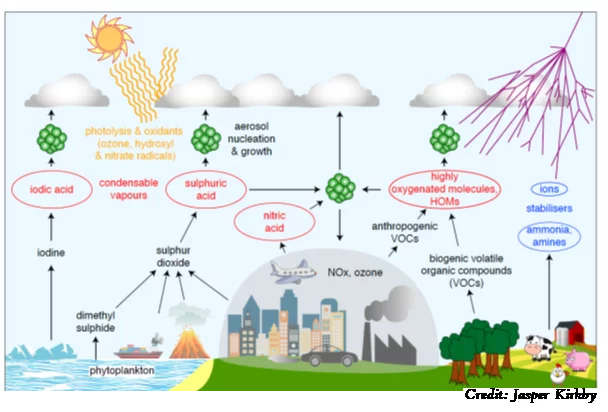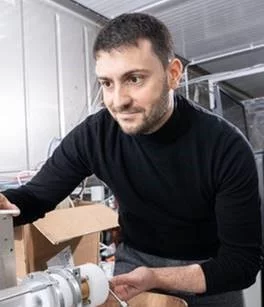The CLOUD experiment at CERN will be recreating particle formation in key regions of the globe to understand the effects of these particles on regional climates
Super-saturated vapours in the atmosphere can nucleate to form new liquid or solid aerosol particles. These particles are seeds for cloud droplets and without them our planet would be much hotter, and without life. We thus owe our existence to aerosols. The CLOUD experiment (Cosmics Leaving OUtdoor Droplets) at CERN is the world first and only laboratory experiment to reach the demanding technical performance and ultralow contaminant levels required to measure new particle formation (NPF) under controlled atmospherically relevant conditions. At the heart of the experiment is a large stainless steel chamber whose contents is continuously analysed with a suite of state-of-the-art mass spectrometers and particle sizers. CERN’s Proton Synchrotron is used to simulate the influence of cosmic rays generated by our sun on NPF through the modification of atmospheric ion levels.
Since its inception in 2009, CLOUD has provided an unprecedented understanding of the molecular processes involved in atmospheric NPF, and systematically measured NPF rates over a wide range of atmospheric conditions. CLOUD has now identified key atmospheric vapors that contribute to particle formation. They comprise sulfuric acid, highly oxygenated molecules, iodine oxides, and nitric acid (see Figure). Some of these vapors are often insufficient to nucleate alone, and require additional stabilizing species such as bases or ions. These few statements would not have been possible before CLOUD started; at that time sulfuric acid alone was believed to be responsible for atmospheric NPF. CLOUD experimental data are parameterized and implemented in models to improve the representation of aerosols, clouds and climate predictions.
The pillar on which the CLOUD experiment is built is research at CERN. CERN was conceived to build bridges between nations through science, and is an inspiring model of international collaboration. Today, around 15,000 scientists from more than 100 different countries join at CERN towards common scientific goals, regardless of any political, social or religious differences that their nations may have. CLOUD is the only atmospheric chemistry experiment that follows CERN’s model: it involves a consortium of 23 institutes from 15 European countries and the U.S., with more than 100 researchers working jointly on the experiment. As such, the experiment has been an outstanding training platform for several generations of students, postdocs and young scientists. Switzerland has an especially high profile on CLOUD through the PSI and CERN partners. The PSI team is one of the five pillars of CLOUD and has been since the very start of the experiment
Since the beginning of 2021, Imad El Haddad, who is the current research head of the laboratory of Atmospheric Chemistry (LAC), is leading the PSI team at CLOUD, previously led by Prof. Urs Baltensperger. As Principal Investigator of the PSI team, El Haddad is a member of the Steering Committee who is responsible for making the executive decisions on the experiment and steering it scientifically, technically and administratively.
The PSI team has led several of the most important discoveries made at CLOUD, in particular on the role of organic vapors for NPF. PSI maintained this leading in the recent years. The team was amongst the leading institutes that recently discovered a new mechanism for particle formation involving ammonia and nitric acid taking place in polluted environments. In collaboration with the CNRS (France), PSI has provided the first online ultra-high resolution mass spectrometric measurements at CLOUD, achieving 10-time higher resolution than the current state-of-the-art. Also recently, the PSI team has initiated a major new addition to the CLOUD facility: a flow tube system (FLOTUS) that simulates multi-day oxidation in a few minutes. The combination of FLOTUS with the CLOUD chamber will allow recreating for the first time the NPF processes occurring during transport of vapors from their sources. It will extend the accessible atmospheric residence times of molecules under investigation from hours to days. Resulting insights will improve the representation of the spatial and vertical distributions of particles, moreover, far from the sources of pollution, where clouds are most sensitive to particle concentrations.
In their latest report, the IPCC asserted that global warming is due to greenhouse gases, with this effect partly masked by aerosols. Climate change will affect us enormously. The 1.1 degrees Celsius increase that our planet has already experienced represents an average global value, while land areas have already undergone much greater warming – e.g. in Switzerland we are measuring a temperature increase of 1.8 degrees Celsius. This is a key strength of this IPCC report: it looks at climate change on a regional basis, where aerosols may have much more important effects on climate and weather. In the future, CLOUD will focus on recreating the atmospheric conditions found in specific regions of the globe, including the upper troposphere (Amazon, Asian monsoon), Polar Regions, Open Ocean and urban sites, e.g. in China and India. A key principle of CLOUD is that it is closely tied to the real atmosphere. The PSI team will take advantage of their atmospheric observations at the Jungfraujoch observatory and in polluted China and India for a faithful representation of atmospheric conditions at CLOUD. In the next 10 years, CLOUD will provide the basic experimental data that models need with which to understand climate change and its progression regionally.



